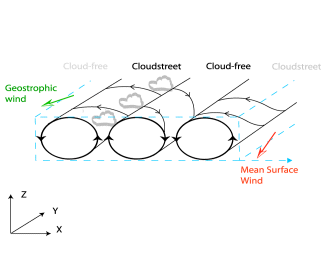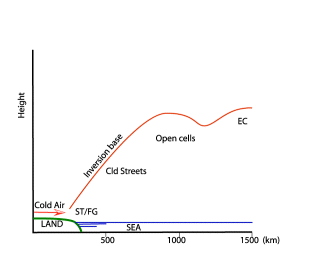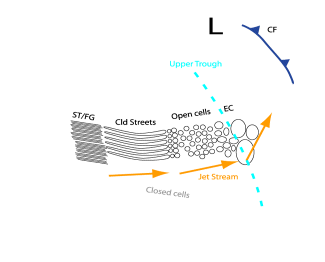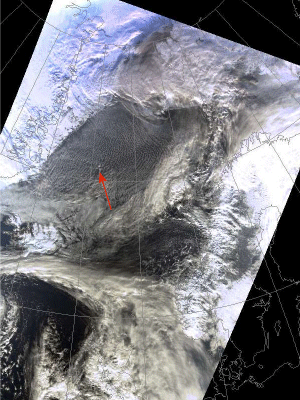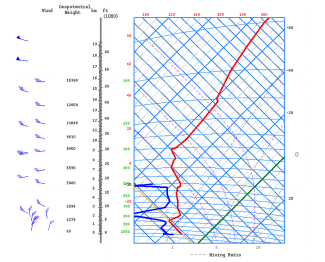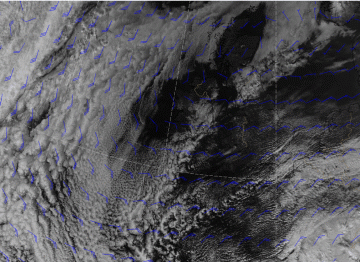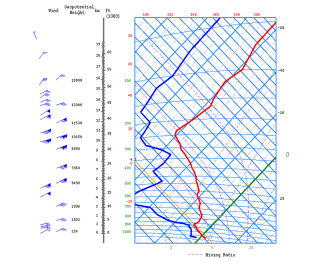Meteorological Physical Background
The organisation of clouds into rows can be explained by the existence of horizontal roll vortices in the boundary layer. The clouds are formed in the upward parts of this roll system. The formation of Cloud Streets by this roll development are mainly caused by two types of instability: dynamic (inflection) and thermal instability. These kind of instabilities may act independently, but can hardly be distinguished in a real flow.
Inflection instability is caused by an inflection point in the wind velocity component perpendicular to the roll system. This inflection point is caused by a combination of the Ekman-layer shear-flow and cold advection. As a result of friction, the winds in the lowest levels will veer with height. The friction-effect decreases with increasing height and therefore the wind will tend to back again because of the cold advection which is present. As a consequence of this turning wind vector, in the lowest layers, a roll system develops.
The inflection point instability can develop in neutral or even slightly stable stratification of the lower troposphere. However, Cloud Streets usually occur under unstable stratification, bounded by an inversion layer above (Thermal Instability). This instability is usually created when cold air flows over a relatively warm surface. Therefore it is most likely that the two types of instabilities can act together, leading to vortex-roll development and the formation of Cloud Streets. Brown (1972) found that under unstable stratification, the inflection instability is enhanced by the thermal instability. Whether inflection instability or thermal instability is more dominant for Cloud Street formation is still a matter of discussion.
Synoptic Environment and Characteristics
In the following paragraphs the typical synoptic environment and other characterisitics will be discussed.
Cloud Streets over sea:
In many cases Cloud Streets can be seen during synoptic scale outbreaks of cold, dry air from continents over a neighbouring relatively warm
ocean. This flow often occurs behind a Cold front (see
Cold Front
). As the cold air leaves the land or ice surface it is modified by vertical transfer of heat and moisture from the underlying water surface.
An inversion will be formed the base of which rises with the distance from shore. The formation of the inversion is, in many cases, stimulated
by NVA and subsequent sinking motion in the stream upwind of the 500 hPa trough-axis (see image below).
The transformation of the air mass eventually leads to the formation of clouds which, under certain circumstances, take the form of Cloud
Streets, and develop roughly parallel to the wind direction (see graphic below). Further downwind from the outbreak, the unstable layer becomes
deeper, the flow becomes more cyclonic and the streets develop into three-dimensional open cells. Near the upper-trough the convection is
enhanced by PVA, resulting in the formation of EC (see
Enhanced Cumulus
) and Comma (see
Comma
).
|
|
|
Good examples of Cloud Streets often occur over the Atlantic Ocean when cold dry continental air from Greenland flows out over the relatively warm sea.
|
07 March 2003/12.04 UTC - NOAA RGB image
|
07 March 2003/12.00 UTC - Tephigram Jan Mayen
|
In the tephigram it can be seen that the lowest 2 km (about 1000-800 hPa) has unstable stratification. This unstable layer is capped by a sharp inversion. Further, it can be seen that the winds in the unstable layer show a slight variation in direction with height: In the lowest half of the unstable layer the winds are veering with height, in the upper half the winds are backing again. This wind profile shows the required inflection point in the cross component of the wind, allowing the formation of roll-vortices and subsequent Cloud Streets. Furthermore, it can be seen from the tephigram and the table below that the windspeed is quite constant with height with values over 20 kt in the middle of the unstable layer.
| Height (hPa) | Winddirection (Deg) | Windspeed (kt) |
| 1007 | 010 | 17 |
| 1000 | 015 | 17 |
| 925 | 020 | 23 |
| 850 | 350 | 25 |
| 772 | 295 | 23 |
| 700 | 295 | 23 |
Over Land:
Cloud Streets also occur over land surfaces. Frequent examples of this type of Cloud Street occur in polar maritime air behind Cold Fonts, when
a ridge of high pressure is forming. Heating of the land surface enhances the instability in the lowest layers. The high pressure provides the
subsidence inversion which is needed to limit the convection. Furthermore, because of the cold advection the condition of the turning wind
vector is also fulfilled and Cloud Streets can develop. As a consequence of a larger variation in terrain roughness, the pattern of the Cloud
Streets is less regular than over sea.
|
19 February 2004/12.00 UTC - NOAA Ch1 image, Surface/Geostrophic wind
|
In the example above Cloud Streets can be seen over The Netherlands, NW Germany, the middle part of the UK and over NW France. This situation was characterised by a cold air outbreak behind a Cold Front. Furthermore, it can be seen that the surface wind is orientated following the left side of the Cloud Streets, whereas the geostrophic wind is orientated following the right side of the Cloud Streets. In this case Cloud Streets can be seen both over land and over water. If the fetch over the sea becomes larger, the organisation of the convection turns into a cellular structure. In the English Channel, a Convergence Line has developed. (See Convergence lines over Sea or lakes ). A tephigram of De Bilt shows well the characteristics favourable for Street development. Again, the required inflection point in the cross component of the wind in the unstable layer can be seen.
|
19 February 2004/12.00 UTC - Tephigram De Bilt
|
|
| Height (hPa) | Winddirection (Deg) | Windspeed (kt) |
| 1028 | 060 | 12 |
| 1000 | 065 | 25 |
| 925 | 080 | 25 |
| 850 | 075 | 35 |
| 700 | 065 | 45 |
